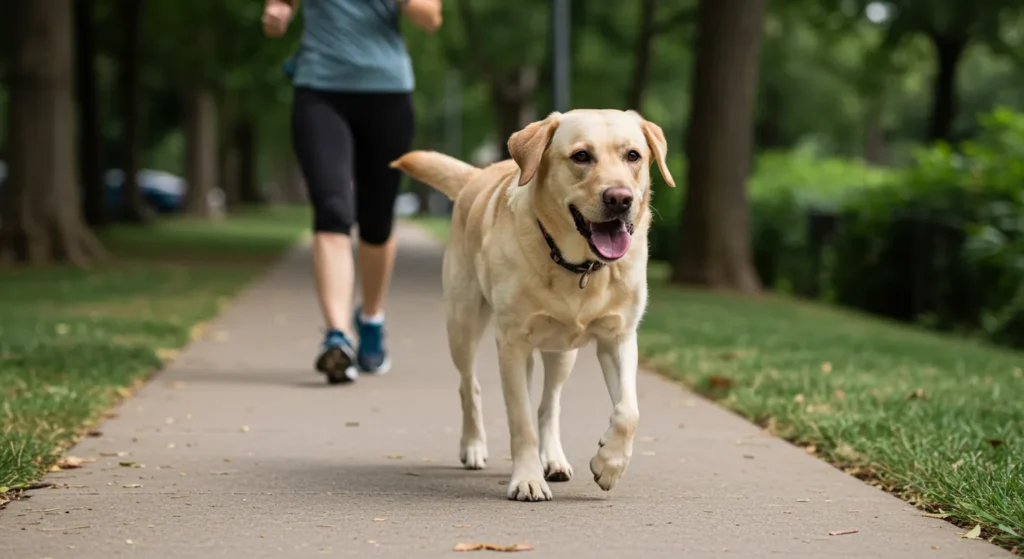More Than Just Potty Breaks: How Daily Walks Improve Dog Behavior
Thing about that moment your dog sees you reach for the leash. The excited tail wags, the happy dance, maybe even a little bark of anticipation! It’s pure joy, isn’t it? We know our dogs love their walks, but sometimes, especially on busy days or during bad weather, it feels like just another chore – a quick trip outside for potty business and back indoors.
But what if I told you that daily walk is one of the most powerful tools you have to shape your dog into a happier, calmer, and better-behaved companion? It’s far more than just physical exercise; it’s a vital part of their mental, emotional, and social well-being. Understanding how profoundly daily walks improve dog behavior can change your perspective, turning that routine task into a cherished opportunity to connect with your furry friend and unlock their best self.
Summary

Burning Energy: The Physical Foundation for Good Behavior
This might seem obvious, but it’s the cornerstone of why walks are so crucial. Dogs, depending on their breed, age, and individual personality, have varying dog exercise needs. Without a proper outlet, that pent-up energy has to go somewhere, and often it manifests in ways we find undesirable, impacting positive dog behavior.

Reducing Destructive Behaviors
A bored dog with too much energy is often a destructive dog. Chewing furniture, digging in the carpet, excessive barking, or frantic zoomies indoors can all be signs that your dog simply needs more physical activity. Daily walks provide a constructive way to release this energy, leaving them more relaxed and less likely to create their own (destructive) entertainment at home. Think of it like this: a tired dog is often a good dog.
Promoting Better Sleep
Just like humans, dogs sleep better when they’ve had adequate physical exertion during the day. Regular walks help regulate their sleep cycles, leading to more restful nights (for both of you!) and a more balanced energy level throughout the day. This is one of the key benefits of walking your dog that contributes to overall calmness.
Maintaining a Healthy Weight
Obesity in dogs is a major health concern, leading to joint problems, heart disease, diabetes, and a decreased lifespan. Daily walks are essential for weight management, helping to burn calories and keep your dog in good physical condition. This physical well-being directly impacts their mood and overall behavior.
Mental Stimulation: Exercising the Mind
A walk isn’t just physical; it’s a sensory adventure for your dog. Their sense of smell is incredibly powerful, and a walk provides an ever-changing landscape of scents to investigate, offering crucial mental stimulation for dogs.

Preventing Boredom and Anxiety
Imagine being stuck in the same house day after day with little new stimulation. It would be incredibly boring, right? For dogs, walks offer vital mental enrichment. Sniffing new smells (the
“pee-mail”!), seeing different sights, and hearing various sounds engage their brains, preventing boredom that can lead to anxiety, depression, or behavioral issues. This is a key way walks help reduce dog anxiety. This mental workout is just as important as the physical one.
Building Confidence
Successfully navigating the environment on a walk can build confidence, especially in timid or anxious dogs. Encountering new things (from a safe distance initially, if needed) and learning to cope with them in a positive way helps them become more resilient and less fearful. The routine and predictability of a good dog walking routine also provide a sense of security.
Enhancing Trainability
A mentally stimulated dog is often a more focused and trainable dog. The engagement they experience on walks can translate to better focus during training sessions. Plus, walks offer real-world opportunities to practice commands like “sit,” “stay,” “heel,” and “leave it,” reinforcing learning in different environments.
Socialization and Environmental Exposure
Walks are prime time for dog socialization and learning about the world, understanding how to interact with it appropriately.
Positive Exposure to Sights and Sounds
The world outside your home is full of stimuli: cars, bicycles, strollers, other people, different noises (sirens, lawnmowers, etc.). Regular, positive exposure on walks helps your dog become accustomed to these things in a non-threatening way, reducing the likelihood of fear-based reactivity or aggression later on. They learn that these everyday occurrences are normal.
Opportunities for Social Skills (If Appropriate)
For dogs who are generally comfortable around others, walks can provide valuable opportunities to meet other dogs and people politely. Learning appropriate greeting manners (or, equally important, learning to calmly ignore others when asked) is a vital part of socialization.
Important Note: Always manage interactions carefully. Advocate for your dog – don’t let unleashed dogs rush yours, and respect your dog’s comfort level. Don’t force greetings if your dog is fearful, anxious, or reactive. Sometimes, just calmly observing other dogs or people from a distance is the most valuable form of socialization for that particular dog on that day.
Strengthening the Human-Animal Bond
Shared experiences build bonds. Your daily walk is dedicated quality time spent together, focused on each other away from household distractions (like phones or TV). This shared activity strengthens your relationship, builds trust, and reinforces your role as their trusted leader and companion. This bond is fundamental to why daily walks improve dog behavior – a dog who trusts and feels connected to you is more likely to listen and respond positively to your guidance.

The Walk as Training Time: Reinforcing Good Habits
Don’t just let the walk happen to you and your dog; use it proactively as a training opportunity.
Practicing Loose-Leash Walking
This is perhaps the most obvious and beneficial training opportunity during a walk. A dog constantly pulling on the leash makes walks stressful and potentially dangerous. Consistently practicing loose-leash walking techniques (using positive reinforcement methods) turns every walk into a productive training session. The leash training benefits extend beyond just the walk itself, teaching impulse control and focus.
Reinforcing Basic Obedience
Use natural pauses and transitions during your walk to practice commands:
- Ask for a “sit” or “wait” before crossing the street.
- Practice “stay” while you pause to tie your shoe or chat briefly with a neighbor.
- Work on “leave it” when encountering tempting distractions on the sidewalk (discarded food, interesting trash).
- Practice recall (“come”) in safe, appropriate areas.
This integrates training seamlessly into everyday life, making it more relevant and effective for your dog.
Establishing Routine and Structure
Dogs thrive on predictability and routine. Knowing they can count on their daily walk(s) at roughly the same time provides essential structure and predictability to their day. This reliable dog walking routine can significantly reduce dog anxiety and behavioral problems that often stem from uncertainty or boredom. It helps them understand the rhythm of the day and anticipate positive events.
(Conclusion)
The simple, consistent act of walking your dog every day is an investment with incredible returns for their well-being and behavior. It goes far beyond fulfilling basic potty needs; it directly impacts their physical health, provides essential mental stimulation for dogs, aids in crucial dog socialization, and significantly strengthens your bond. When you truly understand and observe how daily walks improve dog behavior – reducing anxiety, curbing destructive habits, building confidence, and fostering a deeper connection – it transforms from a mere task into a vital, rewarding cornerstone of your shared life. So grab that leash, open the door, and step out together; you’re not just going for a walk, you’re actively building a better, happier life for your best friend.
Release Physical Energy: Daily walks help burn pent-up energy according to dog exercise needs, reducing destructive behaviors and promoting better sleep.
- Provide Mental Stimulation: Exploring sights, sounds, and especially smells on walks prevents boredom and helps reduce dog anxiety.
- Build Confidence: Successfully navigating the environment and experiencing new things positively helps dogs become more resilient and less fearful.
- Aid Socialization: Walks offer controlled exposure to the world, people, and potentially other dogs, improving dog socialization skills when managed properly.
- Strengthen Your Bond: Quality time spent walking together builds trust and deepens the connection, reinforcing positive dog behavior.
- Offer Training Opportunities: Walks are ideal for practicing loose-leash walking (leash training benefits) and reinforcing basic obedience commands.
- Establish Routine: A predictable dog walking routine provides structure, which can significantly reduce anxiety and behavioral issues.
- Support Overall Health: Regular walks are crucial for maintaining a healthy weight and physical condition, which directly influences mood and behavior.
**Sidnir Vieira**
Founder of TechHavela
A passionate pet and tech content creator, helping dog owners across the U.S. make smarter decisions for their furry friends.



